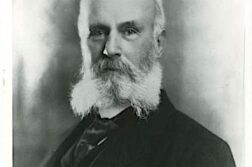DESCRIBED by The New York Post as a “Spinster in Steel,” Martha May Eliot sat down in 1922 and wrote to her mother to tell her that she had found a “two bedroom house, so that there is always a room free for guests.” Eliot was expressing her delight that she and Ethel Collins Dunham had finally found a house to share, and she made no effort to hide the fact that they would be sleeping in the same bed. These two remarkable women, everyone knew, were more than just “friends.”
The prevailing scientific view at the time was that lesbianism, “sexual attraction or sexual activity between women,” was that of “Inversion Theory,” which held that women who suffered from it were born with a “reversal of gender traits.” Pioneering psychiatrist Richard von Krafft-Ebing, an early exponent of this theory, referred to lesbians as “masculine souls heaving in a male bosom.” (He also applied his theory to male “inverts.”)
Inversion theory was certainly a view encountered by Eliot and Dunham as they began their careers. Radclyffe Hall’s The Well of Loneliness would arrive in America in 1928 and be ruled “not obscene” by the New York City Court of Special Sessions on April 19, 1929, and thus fit for publication. Sensational court cases such as this would raise the profile of the issues surrounding sexuality. As lesbians, Eliot and Dunham would experience the effects of this renewed public interest.
One such interested public commentator was Senator James Reed, who would speak openly about the need to address the problem of female “celibates” whose male attributes, he declared, led to the dangerous consequence of their refusal to make babies. Many people in the early 20th century agreed with Reed that lesbians were “accidents of nature,” and such views had a hugely detrimental effect on how they were treated. As late as the 1970s, authors such as Anne Mary Wells, writing about the life of suffragist Mary Emma Woolley, nearly abandoned the project entirely when she found Wells’ love letters to another woman, only publishing when she convinced herself that the women’s relationship was never physical. Thus it’s not surprising, what with the prevalence of such views, that lesbian scientists have often been erased from history.
Lesbians like Dunham and Eliot were considered “endocrine perverts and derailed menopausiacs” in the early 20th century. A number of LGBT people who wanted to explore this hypothesis entered fields of science that could help them to unwrap the “mystery” of their sexual orientation. One such scientist was Howard Brown, a doctor at New York University who was the first physician to publicly announce his homosexuality and would later write that he became a scientist “to solve the riddle of my sexual identity” and to explore the science behind it. For Eliot and Dunham, this was not their motive. They became scientists and doctors for the singular purpose of using the tools of science to improve the health of women and children—a fact that has often been lost due to the notoriety of their personal lives. Both women made important contributions to health care policy and administration, and they were remarkable scientists in their own right.

[Editor’s note: Today, the Martha Eliot Health Center, part of Children’s Hospital in Boston, continues to honor their achievement.]
Rebecca Batley, a historian and writer, has a particular interest in the art of the late 19th and early 20th centuries.







